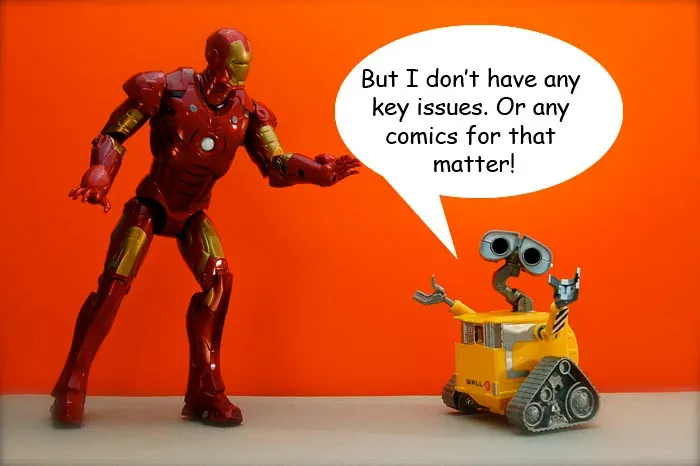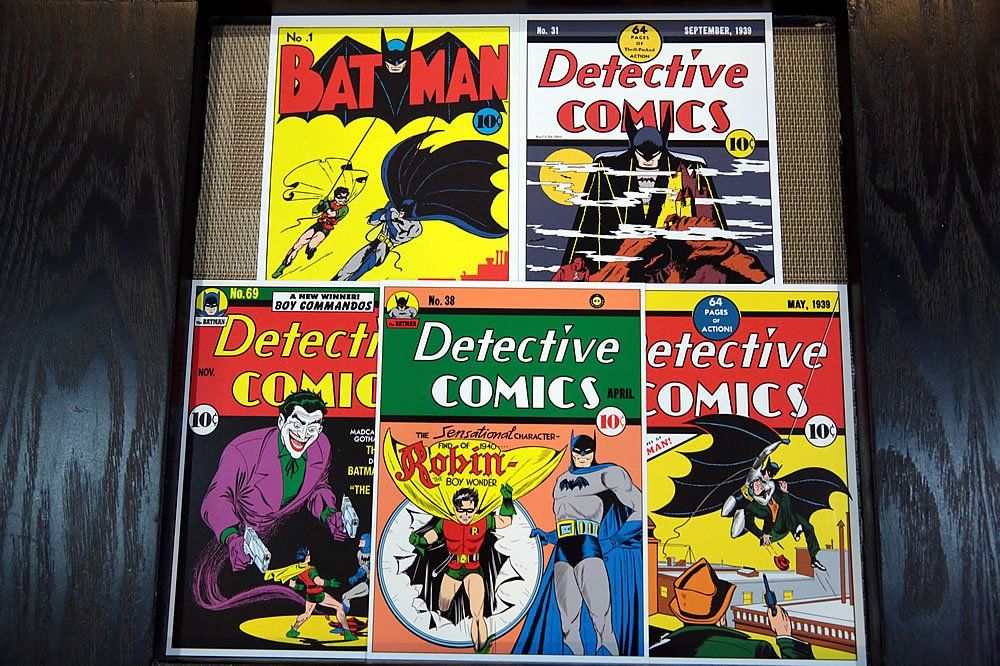Collecting Comics
There are people who read comics and people who collect comics. Some do both.
This section of the The CGC Comic Shop site is dedicated to those people who, on top of reading their comics, also love to collect them. We will try to amass collecting tips and tricks from seasoned collectors who have been collecting comics for decades.
The focus is on fun. We won't have much on collecting as a means to make money, there are other places on the internet that focus on the monetary aspects of collecting. Hopefully we'll give you some information that is both useful and entertaining.
1. Start Collecting Comics Slowly.
Take your time learning about popular superheroes and their key issues. Key issues are more likely to increase in value. When you start purchasing comic books it’s best to buy the ones you really like because then you’ll always be happy about your purchase. Decide on a monthly budget and stick to it, or you may find yourself running out of comic book funds and storage space way before you have the collection of your dreams. Pace yourself in the beginning is our #1 piece of advice.
2. Get Familiar with Popular Artists and Writers.
As you sit down and read your first handful of comic book stories, you’ll be exposed to several writers and many art styles. When you find a favorite artist or writer, turn back to the beginning of the issue and write down the author’s or artist’s name. Search online for other issues written or illustrated by the same person to expose yourself to stories and possibly key issues you wouldn’t normally find. Sometimes comic books can be key issues if their is something very special about to cover art.
- Stan Lee, Jack Kirby, Chris Claremont, Frank Miller, Kevin Eastman, Alan Moore, Warren Ellis, and Mark Millar are all popular comic writers.
- Jack Kirby, Todd McFarlane, Frank Miller, Steve Ditko, Jim Lee, Neal Adams, Alex Ross, John Byrne, Kevin Eastman are popular comic book artists.
3. Only Buy Paper Comic Books.
Most comic books are first published in short installments called issues, which are about 10–20 pages long. Issues can be either in physical formats or digital formats. Digital formats will not increase in value over time and in most cases cannot be sold or exchanged.
If money is an issue and you are willing to wait, you can often save money by purchasing a trade paperback (TPB)) containing five or so issues in one volume, or a graphic novel containing a complete story arc, but graphic novels rarely ever increase in value. Obviously, trade paperbacks and graphic novels are also easier to store than single issues of comic books, if you already have a bookshelf or table to place them on.
- Some independent artists only publish as a graphic novel or digital comic book.
- If you’re looking to build a comic book collection that increases in value over time then stick to physical copies
4. Hunt for Comics in Other Places Besides a Comic Book Shop.
Once you have started collecting comic books, you may enjoy hunting for older key issues or issues to complete a series. Try visiting flea markets, garage sales, thrift stores, and antique shops to see what’s available. You never know, you might find the holy grail of comic books at a garage sale, an Amazing Fantasy #15!
5. Network with Other Comic Book Collectors.
Make friends with other comic book collectors browsing shelves at the comic book store or at a comic con. Trade comic books with them, or loan and borrow books so you can read a comic book without having to buy a copy. Many collectors have reader issues and issues that they don’t read and protect with various methods.
6. Attend Comic Cons.
There are dozens of Comic Cons each year in the World focused on collecting comic books that draw thousands of fans to meet the people who create comics, take pictures with actors of superhero movies, find deals on new or rare comics, or hear announcements about upcoming comic books and movies. The most famous is San Diego Comic-Con, but it is by no means the best comic con for serious collectors.
7. Search for Comic Books with The CGC Comic Shop
8. Know the Grading System.
Individual comic books are graded for quality to give a score relative to the condition the comic book is in. A rating of 0.5 (Poor) means there are pages or part of the comic book’s cover is missing, or that the comic has been heavily damaged by spilled substances, which might be acceptable for Golden Age and Silver Age comics, but rarely every okay for Bronze, Copper, and Modern Age comics. A rating of 10.0 (Gem Mint) means the comic is in perfect condition, with no blemishes. Comic books with a higher quality grade are much more valuable.
However, Modern Age comic books drastically lose value if they are graded a 9.6 or below in most circumstance so be aware that if you are buying a comic book that came out after 1990 it needs to be a 9.8 to make sure it holds its value. To make sure you are getting what you pay for when collecting comic books, there are trusted companies such as CGC and CBCS that will grade and encapsulate comic books as shown below.
9. Search for Key Issues.
The truly rare key issue comics can be worth hundreds or thousands or even millions of dollars and be the holy grail of a collection. While older comic books like those from the Golden Age are worth more in general, the most valuable ones involve a key event in a popular series. Here are a few types of key issue events:
- The first issue of the series (e.g., Giant Size X-Men #1, Iron Man #1, The Amazing Spider-Man (ASM) #1, Teenage Mutant Ninja Turtles #1).
- The first appearance of a major character (e.g., The Green Goblin in ASM #14, Spider-Gwen in Edge of Spiderverse #2).
- The first appearance of a popular weapon/item or new costume (e.g., the symbiote suit in ASM #252).
- Low print run issues, which are usually toward the end of a series but not always.
- Low print run variants such as high ratio variants (e.g., 1:1000) or artist/store exclusives.
10. Flip Modern Key Issues
Every Wednesday is new comic book day (NCBD) so your local shop will most likely be filled with comic book collectors looking for that day’s hottest comic book. Often an issue will come out on Wednesday that has a 1st appearance of a new superhero or something significant happens in that issue and it will start trending among the community. If you can get the issue for cover price then you can flip it on eBay and use that money to buy a Silver or Bronze Age key issue. Flipping can be risky because many sellers do this and supply might outweigh demand. There’s a lot to learn when it comes to collecting comic books and flipping comics for a quick score so make sure to pay attention to demand and price action.
Handling Your Comic
In order to accurately grade a book or to examine it for restorations, collectors need to know how to properly handle comic books. While these guidelines may seem obvious to the veteran collectors, those new to the hobby need to learn these important lessons.
First: Be careful removing or inserting a comic book into or out of a bag. Many bags have tape on the cover flap and if you are not careful, the tape can catch the cover of the book. Make sure that if your bag has tape on the back of the bag that you hold the tape back and away from your comic.
Second: Always handle the comic with care and in the palm of your hand. If possible try to wash your hands before handling a comic as the oils from your hand can cause damage to the comic book. Another suggestion is to use gloves while you examine the book.You can also hold the bag and board in the palm of your hand and rest the book on the bag.
Be sure to turn the pages carefully, allowing each page to fall down gently on its own. Try to avoid placing any pressure on the comic book or on the spine of the book. Try not to open the book any more than is necessary to inspect it.
Third: To prevent spine stresses and/or tics you should never open the book up completely. The more you open a book, the more pressure that is placed on the spine, and too much pressure can cause ticks or wear on the spine by the staples or may create a spine roll. You need to inspect every book before you send it off to be graded, so handle it with EXTREME care while you check for the grading criteria.
Hopefully now you have a good grasp on how to start collecting comic books and which comics to buy that increase in value over time.
Please remember if you want individual advice
Feel Free to contact us at Thecgccomicshop@gmail.com
CENTS OR PENCE?
The cents or pence debate only applies to American comic books and not British-produced comics like Dandy and Beano.
In the 1940s and 1950s, some American comics found their way over to the United Kingdom through American servicemen, through friends and family. Throughout the 1950s, the adventures of Superman and Batman and the like were reprinted and re-packaged for (mostly) the British and Australian markets.
In late 1959, the first American comic books were officially imported and distributed to newsagents and other magazine outlets. Batman #127 and Superman #132 (both cover dated Oct 1959) led the way in small quanities. The floodgates opened the following month with cover dates of Nov 1959. The quantities ordered would probably have been quite small as retailers tried out these new comics which would take shelf and counter space away from the vast array of British comics that had been sold for decades.
British editions of American comics were printed at the same time, on the same paper using the same machinery. The proportion of British copies was generally somewhere up to 5% of the print run but was probably much lower in the early days of Marvel and DC UK distribution, nearer 2-3%.
At the end of a print run, in the case of the early Marvels, a 9d (ninepence) cover price plate was substituted in place of the American 10 cents. For DCs, the cover was hand-stamped. The stamping varies - some can be quite light, others quite heavy and some can be stamped twice when the person concerned missed the first time!
Early Marvels have additional distributor information in the indicia - a single line saying Sole Distributors in the United Kingdom - Thorpe & Porter Ltd. But this needs comprehensive checking. There are also a few instances on 60s Marvel comics where the British cover paper seems to be fractionally thinner than on the US edition (eg Fantastic Four #56) but this again needs comprehensive checking.
Rather than call all these comics UK editions, it would perhaps be more accurate to call them 'pence copies' or 'British priced variants'. Overall they cannot be said to be a reprint of the US edition or, as such, inferior .
In fact it could be argued that in this day and age of variants and alternative covers offered as retailer incentives, British pence copies of American comics are much rarer and have an attraction all of their own. In very high grades or for key issues, one could argue that British pence copies offer value for money.
Some UK collectors prefer UK pence editions of American comics as that 's what they remember as children.
Other collectors prefer the purism of the cents copy, that an American comic should have an American cover price.
What it comes down to is condition, personal preference and spending power.
An early copy of Amazing Spider-Man in FN cents condition currently may be priced the same as a VFN/NM pence copy. If, for example, you have always wanted an Avengers #1 but see a cents copy is over a thousand pounds in VG condition, would you rather opt for a higher grade, better-looking pence copy for the same amount of money?
Sometimes, though, a cents copy just looks better . For example, some 9d and 10d cover stamps on early Marvels and especially DCs can be very heavy and randomly splattered on a character's face. Many 1970s Marvel comics were ND or Non Distributed in the UK and thus were always cover priced in cents. There may have been the odd issue or small run in a series which was distributed and have a British cover price before becoming ND again. Some collectors may feel that for a consistent looking run, all the copies should be cents.
Traditionally American collectors and dealers have frowned upon pence copies but increasingly they have come to recognise the rarity of these pence copies and perhaps see a potential treasure trove.
Indeed there have been reports of American dealers buying British pence copies and charging a higher rarity value!
It remains an inescapable fact that at the moment cents copies are valued higher than pence copies. Currently, general issues of pence copies seem to be valued at about a half compared to cents copies in the lower grades. From about Very Fine condition onwards the gap tends to widen to perhaps a third of the US value. Key issues in cents in very high grades tend to be stratospheric!
It is difficult to compare with very high grade pence copies and cents copies. Sales of, say, Very Fine/Near Mint Amazing Fantasy #15 or Journey into Mystery #83 pence copies are few and far between.
The highest CGC graded Amazing Spider-Man #1 pence copy was advertised in 2010 at the American cents guide price but only attracted bids at half that value. It remains to be seen if that gap between cents and pence copies will narrow or widen.
For the purposes of this guide, all values are in pounds sterling for pence copies. If a comic is only available as a cents copy, that value is given. If you have a cents copy of something that was available either in pence or cents, it would be reasonable to think in general terms about doubling the pence copy values.
The disparity in prices between pence and cents copies is absolutely at its greatest with major key and number one issues in very high grade. A 9.4 Near Mint, cents copy of Amazing Fantasy #15 (the first Spider-Man) has sold for $227,000. At what fraction would a Near Mint pence copy fetch if one ever became available for auction or sale?
BRITISH FREE GIFTS
Unlike American comics, British comics often came with a free gift. For the most part these were booklets of toys made of card to assemble and novelties. In later years these gifts became more extravagant, often packets of sweets, and would be taped to the cover.
If the tape has been left on the cover, it can very often be yellowed and stained. Sometimes the removing of the gift has resulted in a hole in the cover or a substantial patch of cover art torn away. These are quite serious defects and should be noted. Hasty gift removal may result in downgrading by at least two grades.
It must also be said, however, that collecting British comics free gifts is a hobby in itself. These were designed to be used and thrown away so most have not survived. An unused free gift, particularly an early or very popular one, can add a huge amount to the value of the comic.
Throughout the Guide, there are hundreds of pictures of free gifts, many that are seldom seen and very hard to come by.


7 - Personal Hints from The CGC Comic Shop on starting Collecting Comics
#7 Be Realistic
Amazing Fantasy #15 is the 1st appearance of Spider-Man and let’s be realistic, you’ll never own a copy. Being realistic is the first tip I have for you if you want to get into collecting older comics. You can’t set your sights on a 3 million dollar comic book unless you’re a Voodoo sorceror whose reading of the chicken bones gave them the winning lotto numbers.
But let’s say your favourite character is Moon Knight. The character 1st appeared in Werewolf by Night #32, a book that will set you back about 3 grand. Being realistic understands you might not own that book, but you can set your sights on the 3rd appearance of Moon Knight in Werewolf by Night #37, a £250 book.
#6 Set Your Budget
Once you’ve grounded your wants in reality, determine your budget and stick to it. Then do NOT exceed your budget.
Your budget could be a monthly spending amount or you might save up in order to have a wade of cash to spend at a con. You might even set a top dollar you’ll spend on a single issue, like, say, you’ll never go over £100 on a single comic. So, you can use a variety of methods to set a budget, but do make sure you set one, then stick to it.
Sticking to a budget requires patience. You don’t have to get into an eBay bidding war and you don’t have to make that impulse purchase at a con. If the price tag exceeds your budget, you have to learn to be patient and walk away knowing you can continue your quest to find that comic at the price that makes sense for you and your budget.
#5 Learn Who You are as a Collector
The beautiful thing about collecting comics books is you can approach the hobby in a variety of ways. You, of course, have modern collecting, which is primarily speculating, hoping you get a 9.8 in a hot comic or you catch lightning with a variant cover.
But collecting Silver and Bronze Age comics provides even more variety.
- Maybe you just collect “key” issues, defined as important issues like first appearances.
- You can collect runs. I, for example, have complete runs of old school Moon Knight, She-Hulk, Man-Thing, and an uninterrupted run of Uncanny X-Men from #94 up through when Marvel started renumbering every 5 minutes.
- Maybe you get into it for the artwork and collect covers. If I see a Jack Kirby or Jim Steranko cover for a nice price, I pick it immediately.
- Maybe you get esoteric
- You can collect just Silver Age. You can collect a Direct and Newsstand edition of each title, like I do with Claremont X-Men. You can collect certain creators. And on and on it goes!
The point is there is a variety of ways to collect old comics. Choose what you like and what speaks to you, then get after it!
#4 Get off the Beaten Path
Antique shops might have a comic or two and the thrill here is in the hunt. Really, it’s any place that might sell old stuff…I’ve even asked an antique coin dealer if he happened to have some old comics as well.
Speaking of asking? If you stop at a yard sell make sure you ask if they might have comic books as well. It never hurts to ask and you might get lucky! The point is to make it about the hunt, so try outlets other than shops, even though shops will obviously have your best selection.
#3 Condition
So expect 40 year old comics to be beat up a little bit. That said, condition is everything when collecting vintage comics.
First, read our page on CGC grading That will help set expectations. But then forget about grade as much as you can. Here’s what I mean: You won’t be able to afford a high grade in most old comics, unless you are independently wealthy. So get the best condition you can, then don’t stress about it.
It’s better to own a comic in a mid-grade condition than to not own it at all. Then, if you happen to find a nice price on a higher condition later, upgrade!
#2 Look for Lots
I love Thor, so I was excited to collect a run from #126 (when the title was renamed The Mighty Thor after starting out as Journey into Mystery)
So what did I do? I looked for a lot, which is a big bunch of comics. I found a lot of Thor comics that someone bundled up and was looking to get rid of at a good price. Because I bought them in a bundle I was able to get them at a steep discount.
I then filled in the issues around those that were included in the lot. But it was that first big purchased that kickstarted me.
#1 Collect What Makes You Smile
This one should be obvious but it isn’t always so. Collecting comics should be fun, so don’t place any undue pressure on yourself. Set yourself a reasonable budget, decide what type of collector you are, then have fun with it.
Comic Book Preservation:
Comic books, like all things, change as they age and not necessarily for the better. Whether from the golden, silver or modern age, comic books are all printed on paper that is made from wood pulp. Lignin (a substance found in wood) breaks down and causes the paper to become increasingly acidic, discolored and brittle. Those of you who collect comic books have certainly seen and handled extremely brittle and discolored books. Conservators refer to this the inherent instability of wood pulp paper as “inherent vice.”
If you wish to preserve your comics, you need to take measures to combat this inherent vice by minimizing factors that accelerate deterioration. Steps that you can take to fend off inherent vice include:
Limiting exposure to high levels of moisture, either in the form of water or high humidity. Both can damage comics and accelerate degradation.
- Avoiding exposure to ultraviolet and visible light, which can cause inks to fade and paper to become yellow.
- Using inappropriate non-archival storage or display materials, such as PVC vinyl plastic bags or boxes, inexpensive wood pulp cardboard boxes, wood pulp mat boards, wooden boxes or wooden frames. Contact with these can cause discoloration.
- Avoiding frequent handling.
- What can be done to preserve comic books?
Take measures to limit exposure to moisture by placing books in archival bags or sleeves made from polypropylene, polyethylene or polyethyleneterephalate (Mylar).
Never store comic books directly on the floor.
Avoid storing books in attics, basements or other damp areas. If no alternative is available, use watertight polyethylene or polypropylene boxes and add a few silica gel packets conditioned to 45-50% relative humidity. The packets will need to be changed periodically.
Limit exposure to light including visible and invisible ultraviolet light. If you wish to display your comics, consider display methods that limit light exposure by avoiding display near windows and turning off the lights when you are not in the room. If you choose to display your books in a lighted showcase case, LEDs on a timer are the best option since they emit minimal ultraviolet light and minimal heat. At The Henry Ford, we have noticed that Mylar covers appear to block some of the damaging effects of light, providing some protection from fading.
All books should be bagged and boarded or encapsulated (see image below) for storage, display and handling. This protects them from dirt and moisture, minimizes flexing and stress of the fragile paper, and protects from the oil and salt in people’s hands. The use of archival materials and methods for storage and display can have a big impact on the longevity of your collection.
The use of acid-free, lignin-buffered mat board, boxes and paper inserts are recommended. These products are made from cotton, and generally contain calcium carbonate, which helps to neutralize the acid that is formed in the comic books as they age. They do cost a bit more, but are well worth it. The Henry Ford uses a variety of display and storage methods for comic books. Some examples include:
- Plate stands (see image below) can be used to prop up covered and boarded comic books. I’ve seen nice ones online that have a continuous ledge. This method can also be used for comics that are in hard shell cases.
- Hard shell cases are often used by collectors. In our current exhibit, Marvel: Universe of Super Heroes, a slabbed and graded edition of Marvel Comic #1 is displayed on a slanted stand. When these hard shell cases are sealed and made from stable materials, such as polyethylene or polypropylene, they should preserve your comic when stored in an appropriate environment.
It's best to cut a piece of tape that is just slightly bigger than the torn area, making sure that all the edges of the tear are lined up properly before you press the tape into place. Tweezers make this process a bit easier.
ARE "ACID FREE" BOARDS REALLY ACID FREE? Most comic and magazine collectors use backing boards to protect their collectibles from damage by bending. But what if they are causing more harm than good? What if they are adding to the acidity and resulting yellowing of the items you are trying to protect? The sad truth is most backing boards are. Don't believe the packaging when it claims that the boards are "acid free" because only two brands really are. And one brand qualifies for "Pants on Fire". Here is the best research study we have found: https://www.cgccomics.com/boards/topic/205695-are-acid-free-backing-boards-truly-acid-free-time-to-ph-test-amp-find-out/
TOP 10 WAYS TO DESTROY YOUR COMICS AND MAGAZINES (And you probably have never thought about them!)
You can also hear our discussion on the I Want More Comics podcast here: http://podcast.iwantmorecomics.com/?name=2016-08-28_episode_017_mixdown.mp3
10. Storing them where they can get wet. This is less obvious than it seems. Not only do they need to be stored on a raised platform if they are in your basement, you need to ensure that there are no pipes overhead. The worst tragedies we have heard of come from some type of flooding. But wait, you say there no chance of flooding? What about humidity?
9. Reading them while eating. Oops happens!
8. Storing them in a warm area. One of the greatest enemies of paper is heat. This will accelerate the acidification process, causing the paper to yellow prematurely.
7. Packing boxes too tightly. The reality is one of the most commons forms of damage is self-inflicted. Comics were never meant to be slid between one another. Worse, the pressure from the comics being squeezed can cause the same spine roll found when they are stacked.
6. Leaving them in polyethylene (and polypropylene?) bags without changing the bags periodically. These bags contain plasticizers that can leach into the paper, causing the white area of the paper to take on a yellow cast. If the bag feels oily it is already too late. Far too many collectors choose these bags because they are less expensive than Mylar or Mylites. But they forget that these bags must be replaced regularly. When you consider the cost of replacing the bags over a 10 or 15 year period and the value of your time to re-bag your entire collection, the savings in buying cheap bags is truly a false economy. What's that you say? Your store sells them in a bag already? Better ask what kind of bag they use.
5. Tape on bag flaps snagging the comic when it is removed or inserted in the bag. So easy to do. Either take the tape off completely or using double faced tape applied to the bag itself and always peel the flap off the tape.
4. Allowing them to sag and bend in boxes, causing spine cracks. Regardless of how thick the backing board is, it is going to bend under the weight of 40-50 pounds of paper lying on top of it.
3. Stacking them for any period of time, causing spine roll. Remember that the spine side of the issue is actually thicker because of the fold in numerous sheets of paper and the staples. This thickness may not be noticeable in one issue, but stack 10-20 or more issues and that difference becomes multiplied. Add the weight of those issues it won't take long for them to take on a slight bend near the spine. The worst part is it is n easy habit to fall into and it doesn't take long.
2. Storing them nose down. Seriously, never do this. Comics and magazines must always be stored on end such that the spine supports the issue. Even if you have them in a board and bag, the issue can sag in the bag causing a slight permanent bend.
1. Allowing them to be exposed to sunlight. So the simple solution is to never display them. That's a start. But the UV light from florescent lights is also bad. Think you are safe because you don't have flourescent tubes lights around? Think again. What about compact flourescent light bulbs?
It’s not surprising that there is quite a bit of confusion about how to best protect your comic or magazine collection. The Internet has a profusion of suggestions, everything from comments on message boards to blogs to websites reputing to be “experts” on the topic. Unfortunately, most of this information is incorrect despite the sincere efforts of the writers. There seems to be two major causes for this: collectors who forget that paper is subject to a variety of climate issues and what may work in their area is inadequate elsewhere. Additionally, many of these writers have only been collecting for a short period of time. What works for 2 or 3 or 5 years may be destructive 10-20 years later. The point of protecting your periodicals is to avoid problems over the long term.
We at The CGC Comic Shop have one significant advantage because we are collectors ourselves and have been collecting for over 50 years (egads!), well before the first preservation products were invented. During that period we have tried a number of techniques, that is, we have made every mistake in the…ummm… magazine. This has given us the opportunity to see first hand what works and what does not over a prolonged period of time with a variety of approaches. So following are some things we have learned over that time. Keep in mind that your mileage may vary for all the reasons listed above.
BUT WAIT! -- WE HAVE MORE TO SAY... By far the single most important technique in preserving your comics and magazines has nothing to do with spending money on costly products. It is very simple. Always store your collectibles in a cool, dry place. Heat and moisture are paper’s worst enemy and the newsprint used in older comics is particularly vulnerable. A warm air temperature can cause the paper to turn yellow in less than a year. One of the most valuable collections ever found is the Mile High Collection, owned by Edgar Church and uncovered after he passed way by Chuck Rozanski. A significant characteristic of those issues are the whiteness of the pages despite being printed on cheap newsprint in the 40’s. But this is not surprising when you realize that they were stored in his basement, the coolest area of the house, and he lived in Denver, Colorado, known for its dry climate.
Storing print collectibles in a cool area is easy as long as you have air-conditioning or a basement (assuming it will not flood! You DO have everything raised off the floor, right?!?) but humidity is a bigger challenge since some areas of the country tend to be quite humid. Some collectors suggest using silica packets such as those found in shoeboxes, electronic equipment boxes and so forth. These do not work. They are only capable of absorbing a small amount of moisture and once they reach their maximum saturation cease to absorb. We have investigated materials that can be baked to dry them out but even these seem to have only limited usefulness.
The most effective method to reduce humidity is to purchase a dehumidifier and have it run continuously in the area where the collectibles are stored. Circulation in this area should also be kept to a minimum so moist air is not introduced. The key here is in realizing that if your area is humid, it is always humid in greater or lesser degrees. The air is constantly circulating in and around your collectibles, so the moisture must be constantly removed from the air. Note, too, that the cooler the air is the less moisture it can hold, so reducing the temperature even further helps as well.
The second most common damage collectors that we know have experienced is bending. Step one in preventing this is to never stack comics or magazines lying flat. This will cause the spines to curl and can occur even if they are stacked for a short period of time. Even standing periodicals on their “nose” end (the end you open them from) will cause warping over time. Comics and magazines should always be stood on the bottom (or top) end with the spine vertical so it provides some support. To prevent the other causes of bending the next most important item you need (besides our BoxSort Upright Dividers) is backing boards. But care needs to be taken in their selection and use as well since they can introduce more acidity to your comic or magazine.
We are a Professional Comic Trader with over 42 years experience in the Comic World . We are a leading CGC Agent , We find Comics for Customers , Press , Buy and Sell , Clean and Restore , Value and Grade etc
Contact info
All Rights Reserved | The CGC Comic Shop
CUSTOMER SERVICE
Open 24/7
Leave us your info
And we’ll get right back to you.
We will get back to you as soon as possible
Please try again later








